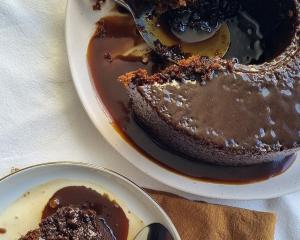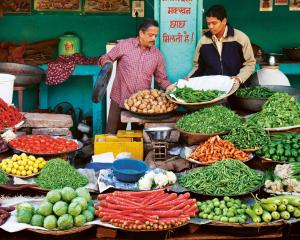
In his new book, Eat Better Forever, Fearnley Whittingstall has aimed to "size up the latest good science and summarise it clearly" together with his own views on healthy eating based on in-depth reading, research, more than 30 years’ experience in the food industry and from talking to experts in the field.
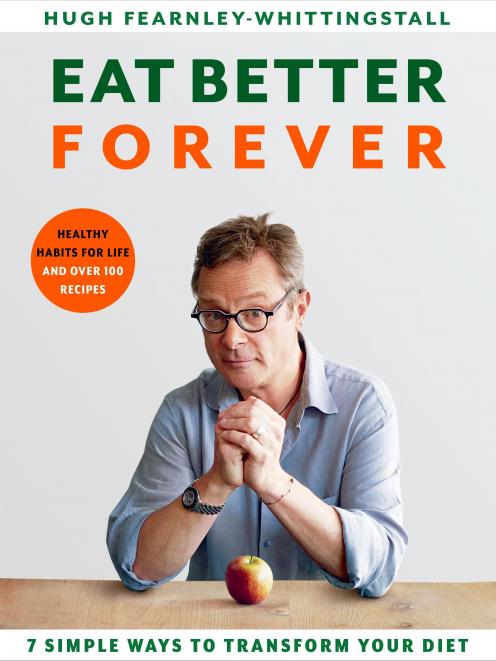
Not a fan of "single fix" ideas or popular diets, he hopes to "buck" that trend with this book.
"Rather I have a cluster of useful and entirely complementary pathways - seven of them, as it happens.
The "seven ways" - go whole food, go varied, go with your gut, reduce refined carbs, factor in fat, think about your drink, eat mindfully - are explained in chapters covering the science, myths and how tos.
They are things he believes will make a genuine difference to people’s health.
"The idea is to help you know more, think more and understand more about food and the good and bad it can do to us."
Fearnley Whittingstall also includes stories of his own journey with food, weight loss and alcohol.
"I’ve always enjoyed ‘good food’, but the meaning of that phrase has evolved for me.
"I’ve developed an approach to eating and living that is working well for me. I’m lighter, healthier, fitter and less anxious than I have been for years. I sleep better and I cope with stress better too."
That’s not to say his approach will work for everyone.
"Tackling several different things, in whichever ways are achievable for you, has got to be the way forward."
Alongside this information he has included healthy recipes for simple breakfasts, healthy lunch boxes, suppers and treats based on eating lots of vegetables, plenty of whole grains, nuts and seeds, as few processed foods as possible, some fish and a little meat.
It is not a weight-loss manual, he says. However, he does include a chapter on how to use the book to do that.
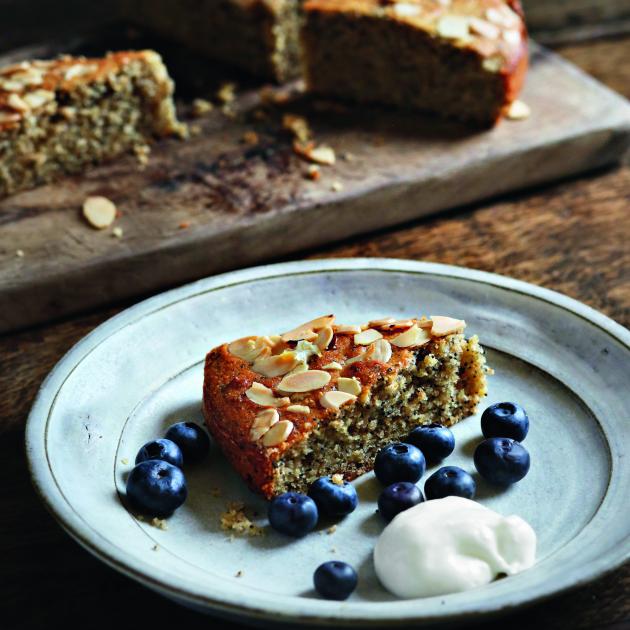
To create this recipe, I started with a basic Victoria sponge and swapped out the white flour for a blend of wholemeal and ground almonds, reduced the sugar substantially and added extra nuts and seeds. The result is delicious — and you really do not miss all that sugar. I love to eat the cake still just warm from the oven, but it keeps well, too.
It’s great with a cup of tea or, for a high-fibre, probiotic pud, enjoy it with a spoonful of kefir or natural yoghurt, and a little heap of fresh berries or roasted fruit compote. The poppy seeds aren’t essential, but I love them for their look and their texture and, like any seed, they are rich in minerals.
Makes 8 slices
125g unsalted butter, softened
70 soft light brown sugar or light muscovado
Finely grated zest of orange or lemon (optional)
100g wholemeal cake flour/fine plain wholemeal flour
2 tsp baking powder
100g ground almonds
25g sunflower seeds
25g poppy seeds (optional)
3 medium eggs
3 tbsp milk or water
About 20g flaked almonds or pumpkin
seeds (or a mix)
Method
Heat the oven to 180degC. Line a 20cm round springform cake tin with baking paper.
Put the butter and sugar, and the orange or lemon zest if using, into a large bowl or a free-standing electric mixer. Use an electric hand whisk or the mixer to beat for a couple of minutes, until light and fluffy.
In a second bowl, thoroughly combine the flour, baking powder, ground almonds, sunflower seeds and poppy seeds, if using.
Add an egg and a spoonful of the dry ingredients to the butter and sugar mix and beat until evenly blended.
Repeat to incorporate the remaining eggs.
Tip in the remaining dry ingredients and fold together gently but thoroughly, finishing by folding in the milk or water to loosen the batter a little.
Spoon the mixture into the prepared tin and spread it gently and evenly. Scatter with the flaked almonds and/or pumpkin seeds. Bake in the oven for 35 minutes, or until risen and golden, and a skewer inserted into the centre comes out clean. Leave to cool, at least a little, on a wire rack.
Remove the cake from the tin and cut into slices to serve. It will keep in an airtight tin for up to 5 days, but you’ll most likely finish it well before then.
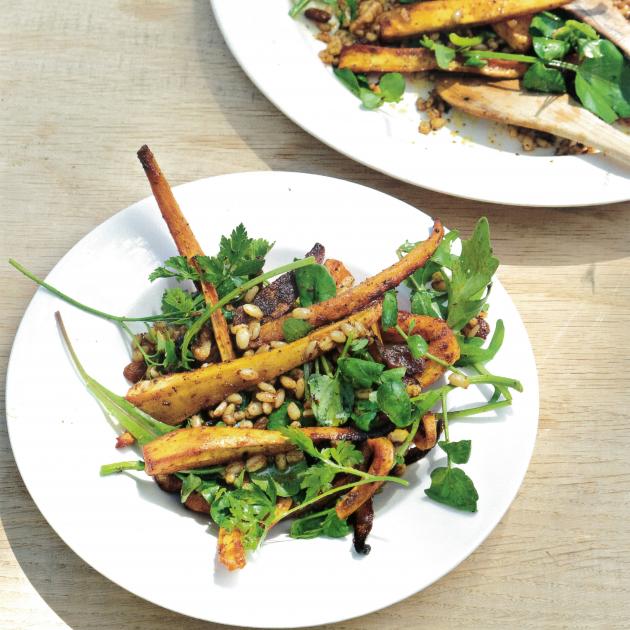
Parsnips are delicious with curry spices, particularly when roasted so that their thin, tapering ends turn delectably sweet and caramelised. Here, spicy roasted parsnips are tumbled with nutty whole grains, raisins and a scattering of walnuts to create a dish with lots of satisfying textures. I like to add some crisp leaves for contrast, too.
Serves 4
150g pearl barley, pearled spelt or whole spelt grain
500g parsnips
2 Tbsp curry paste
3 Tbsp olive or rapeseed oil
50g walnuts, roughly chopped
75g raisins
a bunch of leaves, such as watercress,
rocket or flat-leaf parsley
juice of ½ orange or lemon
sea salt and black pepper
Method
Soak the pearl barley or spelt in cold water for anything from 20 minutes to a couple of hours then drain and rinse well. Put the grain into a saucepan, cover with plenty of cold water and bring to the boil. Reduce the heat and simmer until tender. This will take about 20-25 minutes for spelt, more like 35-40 minutes for barley. Drain.
Meanwhile, preheat the oven to 190degC . Peel the parsnips and trim the base and tip from each. Cut each parsnip in half lengthways then cut each half from top to bottom into long batons, no more than 2cm at the thick end. Don’t worry if they are a bit wobbly and uneven — this all adds to their charm!
Put the curry paste and 2 tablespoons of the oil in a large bowl and mix together. Add the parsnips with a pinch of salt and a twist of pepper and toss the parsnips in the curry spice so they are all coated — you may find a pastry brush helpful for this.
Scatter the parsnips in a large, shallow roasting tray. Roast for about 40 minutes, stirring once, until starting to caramelise. Add the chopped walnuts, raisins and cooked spelt or barley to the roasting tray, stir everything together and return to the oven for 5 minutes.
Remove from the oven and let cool slightly for 5 minutes then toss with the leaves and transfer to a platter or individual plates. Squeeze over a little citrus juice and trickle over a touch more olive oil before serving.

This is a lovely way to eat lamb steak: a modest but flavour-packed serving of meat on a zesty, herby tabbouleh. The meat is rubbed with dry spices - if I’ve got time, I roast whole spices briefly in a dry frying and grind them myself using a pestle and mortar, but if I’m on the fly, I’ll use ready-ground spices.
Serves 4
1 large or 2 medium lamb leg steaks (about 300g-350g in total)
a little olive or vegetable oil
For the herby tabbouleh
150g pearl barley, pre-soaked if time
a large bunch of flat-leaf parsley, tougher stalks removed
a bunch of coriander, leaves picked
a small bunch of mint, leaves picked
a small bunch of chives
grated zest and juice of lemon
grated zest and juice of ½ orange
2 Tbsp extra virgin olive oil
sea salt and black pepper
For the spice rub
½ tsp ground cumin
½ tsp ground coriander
½ tsp ground mixed spice
a good pinch of hot paprika or cayenne
a good pinch of salt
To serve
nutty citrus hummus, warmed
dukka (optional)
lemon wedges
Method
For the tabbouleh, cook the pearl barley in simmering water, according to the pack instructions until just tender (probably 25-30 minutes, quicker if pre-soaked), then drain and leave to cool. Roughly chop the parsley, coriander and mint, and finely snip the chives. Toss the herbs, citrus zest and juice, olive oil and some salt and pepper through the cooled pearl barley. Set aside to allow the flavours to mingle.
Meanwhile, combine the ingredients for the spice rub. Very lightly oil the lamb steak, then rub the spice mix all over it. Leave for 30minutes to come up to room temperature and absorb some of the spices. Then gently scrape off excess spice mix so it doesn’t burn in the pan.
Heat a heavy-based pan or griddle over a high heat. Add the seasoned lamb and "dry-fry" for about 3 minutes on each side, for nicely pink meat (cook it a little longer if you prefer your lamb medium). Transfer to a wooden board to rest for a few minutes.
Divide the herby tabbouleh between serving plates. Slice the lamb steaks into roughly 2cm thick slices and arrange on the tabbouleh. Add a generous spoonful of warm hummus and finish with dukka if you like. Serve with lemon wedges, for squeezing over.
Variations
Meat: Instead of lamb steaks, use beef rump steak or try spicy lamb sausages such as merguez, or strips of leftover roast lamb - fried and seasoned with the spice mix.
Tabbouleh: For a more classic tabbouleh, use cracked bulgar wheat instead of pearl barley.
Or you can replace the barley with another cooked whole grain, brown rice or even quinoa.




